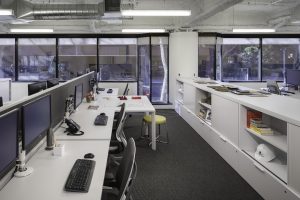Kena David, BCCI’s Director of Sustainability, began an hour-long seminar by asking participants to write down how they think “well-being” looks, feels and sounds. The goal of this exercise was to understand that the WELL Building Standard was designed to benefit people in the built environment.
On average, humans spend 92% of their lives indoors. According to the Center for Disease Control and Prevention, of all the factors that influence an individual’s health and well-being, the physical environment is the most significant factor. In response to this, the WELL Building Standard allows us to transform the spaces we occupy and everything within them to be more healthful. By applying a holistic approach to health and wellness, the WELL Building Standard addresses seven core concepts that affect human health within the built environment: air, water, nourishment, light, comfort, fitness, and mind.
When a work environment is designed and built to the WELL Building Standard, both employees and employers benefit. The issues and impacts of light specifically stood out during the seminar. Light levels in the work environment affect the body’s circadian rhythm, which can then impact sleep patterns and ultimately productivity during working hours. One of the optimizations in the light concept is to locate workstations near windows, not only for access to daylight but also so employees can see the outdoors. Natural light and views of nature are both linked to productivity and increased alertness
Another intriguing WELL core concept is that of comfort as numerous factors influence a feeling of comfort in the work environment. Uncomfortable task chairs and workstations can lead to musculoskeletal disorders such as back pain, neck pain, and osteoarthritis. Fortunately, ergonomic furniture options are plentiful and affordable. Furthermore, indoor temperatures that are either too warm or too cold and distracting noises can also cause discomfort and impact productivity. Maintaining a pleasant indoor temperature and addressing acoustics with sound masking systems and absorptive materials can greatly reduce distractions.

The International WELL Building Institute (IWIBI), began their research and development of standards in 2008. Six years later, in October 2014, version 1 of the WELL Building Standard was launched. Since then, over 1,200 projects have been certified, and there are now 4,000 WELL Accredited Professionals worldwide. A detailed process must be followed to get a project WELL certified. The document submission, performance testing, visual verification, and spot check steps are the same for every project; however, the time and money spent can vary depending on the project typology, size, location, choice of materials, and certification goals. Optimal project outcomes occur when the conversation about WELL certification begins very early on, during programming or even before an owner has selected a location. Early alignment among all stakeholders and project consultants can help save on real estate, design, engineering and construction costs.

BCCI is proud to have our San Francisco headquarters WELL v1 Silver certified under New and Existing Interiors, the first project in San Francisco to achieve WELL certification. We are currently targeting WELL certification for the recent build-out of our new South Bay office in Mountain View. Learn more about WELL here.